Over the last few months I’ve received dozens of emails from people who are struggling with how to have better group conversations.
This guide will help you when it comes to:
- Joining group conversations
- Contributing in group conversations
Years ago I remember worrying about:
- What kind of conversation starters do I need to join a group?
- What other people were thinking of me.
- Trying to come up with the perfect thing to say, not saying it, and replaying events...and overthinking every step of the way.

Tell me if these ring true for you:
“I just feel like I’ll be bothering them if I walk up and start talking…”
“What if they all know each other?!”
“I don’t want to have to be LOUD and interrupt people! it’s just not who I am...”
That’s why I created this guide for you, to help you smoothly join a group so that you can…
...meaningfully contribute to group conversations at work without feeling awkward and self conscious.
...Easily make new friends and contacts at a conference.
...feel comfortable and enjoy group conversations at a party.
And on a deeper level:
...have options of who you surround yourself with. Which as it turns out, has a huge influence on success
...feel like you are the kind of person who can thrive in social situations (which will make it more likely that you will thrive even more in group conversations, creating a virtuous cycle)
In this guide you’ll find some of the best strategies for joining and contributing in group conversations.
To create this guide, I pulled from my experience having 90,000 conversations over 11 years...but I knew that wouldn’t be enough.
I also did a LOT of research into what works and what doesn’t.
The result?
You don’t have to look in 100 different places and piece together quality, actionable information.
It’s all right here for you.
Let’s swan-dive in…
Part 1: Joining
- Myths Debunked: Why You Don’t Have To Be LOUD Or Interrupt People To Be Successful
- BEFORE You Join The Group Do THIS
- Conversational Muscle Memory: How to demolish the fear of approaching people
- Relax: How To Make Yourself Comfortable So That You Can Be Charismatic
- How To Smoothly Join The Group Without Feeling Awkward Or Freezing Up
- What to SAY As You Join A Group: (Word for Word Scripts)
- The +10% Rule: How To Always Be Accepted Into A Group And Never Accidentally Kill The Vibe
- A Visual Guide: Body Language While Joining A Group
- Reading to Doing: Action Steps To Start Using Today
- Checklists To Make Sure You’re On The Right Track
Part 2: Contributing
- BEFORE You Open Your Mouth Do THIS
- How To Get Out Of Your Head And Stay Present In Group Conversations
- Stop Treating Group Conversations Like 1:1 Conversations
- Topics Are Like Trains...There’s Always Another One Coming (How To Go With The Conversational Flow)
- You Don’t Have To CARRY The Conversation (Do this instead)
- How to Jump Into a Conversation That Has No Opening
- Genuinely Connect With Anyone About Any Topic
- Rewire Your Thoughts by Celebrating Small Wins
- Reading to Doing: Action Steps To Start Using Today
- Checklists To Make Sure You’re On The Right Track
Part 1: Joining
Myths Debunked: Why You Don’t Have To Be LOUD or Interrupt People To Be Successful
Let’s strap nuclear bombs to three of the most common myths that are holding people back from succeeding in group conversations.
While we’re at it, let’s also pull back the curtain on what’s really going on behind the scenes.
This is important because: It’s crucial to realize when you’re building a limiting myth in your mind. These limiting myths can unconsciously guide our lives for years or decades. Let’s take back control.
While reading, ask yourself:
- Do I believe this or something similar?
- Is that belief helping me or holding me back from where I want to be?
- How could I reframe these myths into something for helpful?
Myth #1: “I feel like I have to be loud and interrupt people to be successful in a group.”

What’s really going on: When we see someone being loud and interrupting people in a group, it’s easy to make two assumptions:
- I hate him and I never want to be like him.
- If that’s how I have to act to be effective in a group, I’d rather gouge my eyes out with sporks. *Throws hands up and walks away*
Something subtle is going on here- can you spot it?
In the span of two little sentences, we’ve gone from zero to I’ll never even try because I don’t want to end up like THAT.
Think this instead: “Maybe I don’t need to be loud and crazy like that guy, but maybe I could reexamine my behavior and ask myself: “I want different results, what could I change, even if it’s something small that would move me towards where I want to be?
Myth #2: “I always feel like I’m bothering people.”

What’s really going on: At the root of this myth, we’re assuming that we don’t have anything of value to offer the group and we’ll be driven out with fiery pitchforks.
Humans are tribal, and social rejection was a really bad thing thousands of years ago. Even though this fear has outgrown it’s usefulness, it’s still hardwired into us.
Think this instead: “There are many ways I can contribute in a group, and as long as I’m not dragging down the group’s energy I’m not bothering anyone.” (More on the “+10% rule” later in the guide)
Myth #3: “I do not know how to join a group without appearing awkward through my body and conversation. I believe everything about me emits an uncomfortable energy.”

What’s really going on: There’s a lot of assumptions going on in this myth:
- “I know how others perceive me.” (I call this Charles Xavier-ing yourself into other people’s mind, which, unless you’re an actual mutant, is impossible)
- All or nothing thinking: “I believe EVERYTHING about me emits an uncomfortable energy.”
Think this instead: “It's impossible for me to know exactly what other people think of me. If it's impossible to know, then it must be outside of my control. If it's outside of my control, I can’t directly influence it, so I shouldn’t spend energy worrying about it.”
Pay careful attention to the things you tell yourself, they may not be true.
BEFORE You Join The Group Do THIS:
When I was a kid, I loved mazes. And I loved starting at the finish. After doing the last half of the maze, I’d do the first half.
Meeting in the middle felt so good.
Apparently, I was honing my reverse-engineering skills from an early age. Reverse-engineering is awesome because it helps you create a path with the end in mind.
Let's think about the last time you were talking in a group. Can you remember who joined and when? Can you remember if they joined smoothly, or if they just sort of appeared?
I doubt it.
Humans have the gift of overestimating our own importance, especially when it comes to social interactions. It’s called the spotlight effect, and it’s why you think everyone is judging you and noticing you. (Even when they’re not)
Here are three mindsets to use as you start improving your group conversation skills:
- I will mess up, and that will be 100% fine, because people tend to overestimate their own importance, people with almost instantly forget that awkward thing I did.
- Everyone is too worried about other people judging them.
- The more comfortable I make myself, the more effortless my conversations will feel.
Relax: How To Make Yourself Comfortable So That You Can Be Charismatic
Remember the last time you felt comfortable in a conversation.
Were you thinking about:
-Your internal state?
-What the other person thought of you?
-How many people were watching you?
Likely not.
There’s a concept called a “Flow state” where people are engrossed in what they’re doing to the point of being oblivious to their surroundings and internal monologue.
Paraphrased from Thinking Fast and Slow by Daniel Kahneman:
“In a state of flow, maintaining focused attention on these absorbing activities requires no exertion of self-control, thereby freeing resources to be directed to the task at hand.”
The best way to get into a flow state? Have multiple conversations throughout your day.
Having those small conversations throughout your day will help you enter that flow state, and also help you level up your conversation skills.
Two birds, one stone. I love it.
Author James Altucher talks about the concept of improving 1% per day: “Habits don’t change in a day. But 1% a day makes every habit work.”
I’ve been honing my conversational skills for 11 years. I’ve had roughly 90,000 conversations in that time. That equals out to 22.41 conversations per day.
But I never thought to myself: “I have to talk to 22.41 people today!”
I just focused on one conversation at a time.
How did I do it? (And more importantly, how can you?)
Conversational Muscle Memory: How To Demolish The Fear of Approaching People
Step 0: Watch this video on starting and ending conversations:
Step 1: Leave your house. This one is obvious...you have to be around people for this to work.
Step 2: Start tiny (1-3 minute) conversations throughout your day.
- Low Stakes: The more tiny conversations you have, the easier starting those conversations will be.
- "But who do I talk to?!" Everyone you typically come in contact with. The barista at the coffee shop, your doorman, the mail carrier, the waitress at lunch, Bob from accounting.
- "But what do I SAY?!" This actually matters a lot less than you think. There is no perfect line. A good rule of thumb: What the person is doing, wearing, or something in the setting you're both in. (More on this later with word for word scripts)
- Have an exit strategy: No one wants to feel stuck in a conversation, an easy script to politely end the conversation is: "I've got to run, it was nice meeting you [Name]." Bonus: Having an exit plan will make you feel more comfortable jumping into those conversations.
With each small conversation you start, you’re actually doing two things at once:
1. You’re building the skill of starting conversations. Skills are something that you can improve over time, and they become a core part of who you are and how you see the world.
2. Newton’s first law: An object in motion stays in motion. You’re building momentum so that you can start even more conversations throughout your day. It’s a virtuous cycle.
Expert Spotlight: Felicia Spahr
A while back, I invited leadership and charisma coach Felicia Spahr on my blog to talk about how to destroy the fear of approaching people.
In true judo fashion she gave some excellent (and non-obvious) advice:
“When I’m at an event and see a stranger I want to start talking to, my heart starts beating faster, I become self-conscious, and I start to think: “What am I going to SAY?”
But the point isn’t to not feel fear or nervousness when you approach new people. It’s that you feel it, but you know exactly what you’re going to do and exactly what you’ll say to ensure a successful interaction.
Because I realized myself that the reason why I met my fiance and some of my closest friends is because I let myself feel fear, but approach them anyway. In fact, just knowing that meeting the right stranger could change my life is what nudges me out my comfort zone time and time again.”
Hmm. Feel the fear, and do it anyway.
How To Smoothly Join The Group Without Feeling Awkward or Freezing Up
The three most important things to consider when it comes to starting or joining a group conversation are:
Time limit: From the moment you see a group that you want to talk to, start a 10 second timer in your head.
This is crucial, because the longer you wait to speak to them, the less likely you are to do it.
An object in motion stays in motion.
Observe, Orient, Decide, Act. (OODA): Originally developed by military strategist John Boyd as a way to quickly make decisions in the field, OODA will help you make small logistical decisions while approaching a group:
-What side of the group should I approach from? The most “open” side.
-How loud should my voice be? Loud enough to not warrant repeating yourself.
-What should I do with my hands? Gesturing is fine, but generally keep them out of your pockets and around your belt level. No fidgeting.
-What should my body language be? Open body language is good, no arms crossed, collapsed posture.
Imagine good things happening: This one is a little different. Most of us have PhDs in negative visualization. It's essentially how we survived as a species.
But when you're approaching a group, this approach isn't so helpful.
Imagining the best possible outcome is a powerful method to hack your way to in-the-moment confidence.It's also an excellent way to eject from a vicious cycle and make it more likely for a virtuous cycle to occur.
The +10% Rule: How To Always Be Accepted Into A Group And Never Accidentally Kill The Vibe
Have you ever been in a group and a new person joins and they immediately lay this gem that acts as napalm to the group’s energy:
“So I had to put my dog to sleep yesterday…”
Everyone starts scooting away slowly while murmuring “Oh, I’m sorry…”
Even worse, no one will be able to switch topics because they don't want to come off as insensitive.
Boom. Just like that, you have a downer black hole. Nothing escapes, not even light.
Group conversations are typically full of light banter.
No one ever thought to themselves, “Oh, I wish someone would bring us down a little...we’re having too much fun.”
The secret to never getting that awkward vibe from a group is simple:
Match the group’s energy, then add 10%.
How to increase your energy level: Be enthused. I have a friend named Tim. Tim has the ability to get excited about almost anything.
If you tell him about some new thing you’re doing or trying, he’ll get excited along with you.
He rides that wave with you. It’s infectious. Even if you don't know much about that particular topic, if you show enthusiasm, people will love you. (Side note: in part two of this guide, we'll cover how to be interested in any topic using something I call the spokes method.)
As a general rule, here are some topics to avoid:
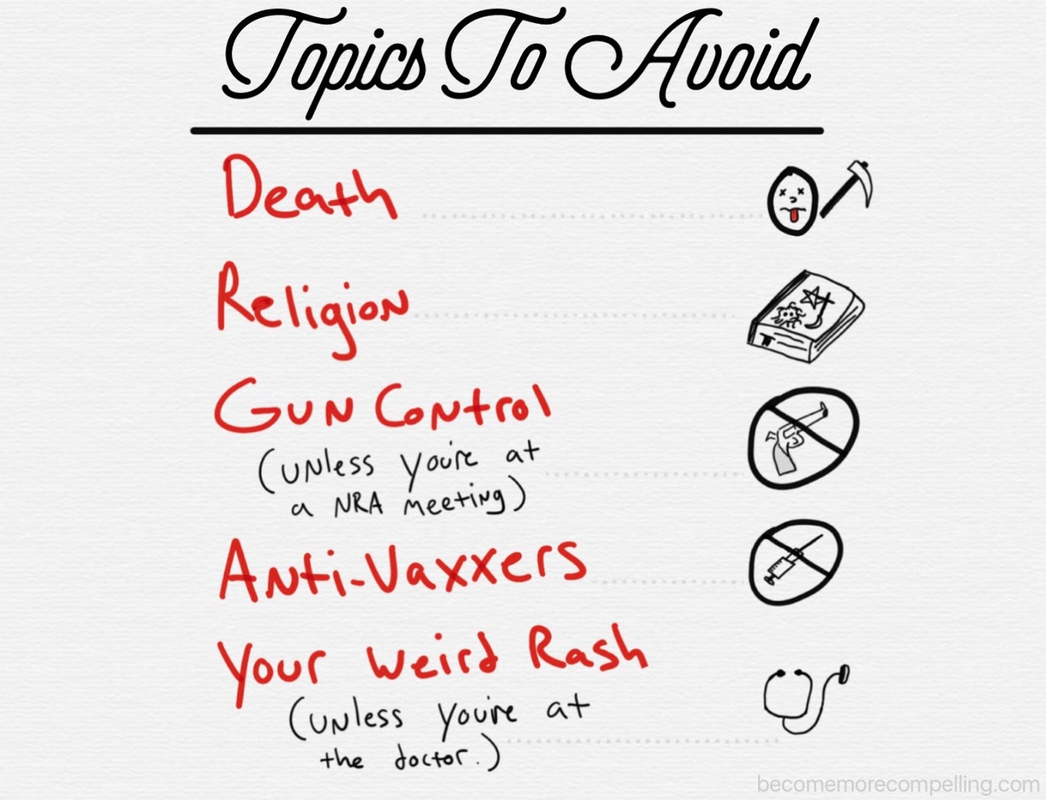
What to SAY as you join a group: (Word for Word Scripts)
Aha!
Now we're down to the good stuff, hopefully you didn't just scroll down to this section to get a quick fix.
Word for word scripts are insanely helpful when it comes to starting a conversation.
But here's the dirty little secret: Scripts alone will never work. So if you're just looking for a quick fix, please do us both a favor and close this guide immediately.
Still here? Good.
In this section, I'm going to give you some examples of tested word for scripts to start group conversations, but I'm also going to show you how to create your own so that you can always have the perfect script for any situation.
(Notice how none of these are particularly fancy)
Script #1: “Hey guys, do you mind if I hang out for a couple of minutes?”
Why this works: You're asking for permission to join their group, coupled with a time constraint.
Asking for permission is a very subtle form of persuasion. It takes the other person's feelings into consideration.
A time constraint is crucial because it answers a main objection in people's minds: “Will this person overstay their welcome?”
Script #2: “Excuse me, I couldn't help but overhear, are you guys talking about XYZ? Because [reason]”
Obviously, this one is a little tricky…If what you overhear seems super serious, maybe don't use this one. But if someone's talking about the new superhero movie trailer, rock on.
Why this works: A dash of permission, and a good segue into the current topic. Note the word “because”. A famous study on influence uncovered that strategically using the word “because” increases compliance.
Create your own (Mix and match):
Here are the minimum effective building blocks of a good script:
-Permission. Taking the group's feelings into consideration by obtaining verbal or nonverbal permission to continue. Key phrase: “Would you mind…”
-Time Constraint. Answers the main objection in people's minds: “Will this new person hang around too long?!” (If you're cool, no one cares how long you stick around) Key phrase: “I can only hang out for a couple of minutes…”
-Environment. What kind of environment are you in? It's their something interesting you can comment on?
A Visual Guide: Body Language While Joining a Group
For this section, we’re going to look at the most effective ways to join a group.
Angle of approach. Every group will typically have an “opening” that will be best to approach from.
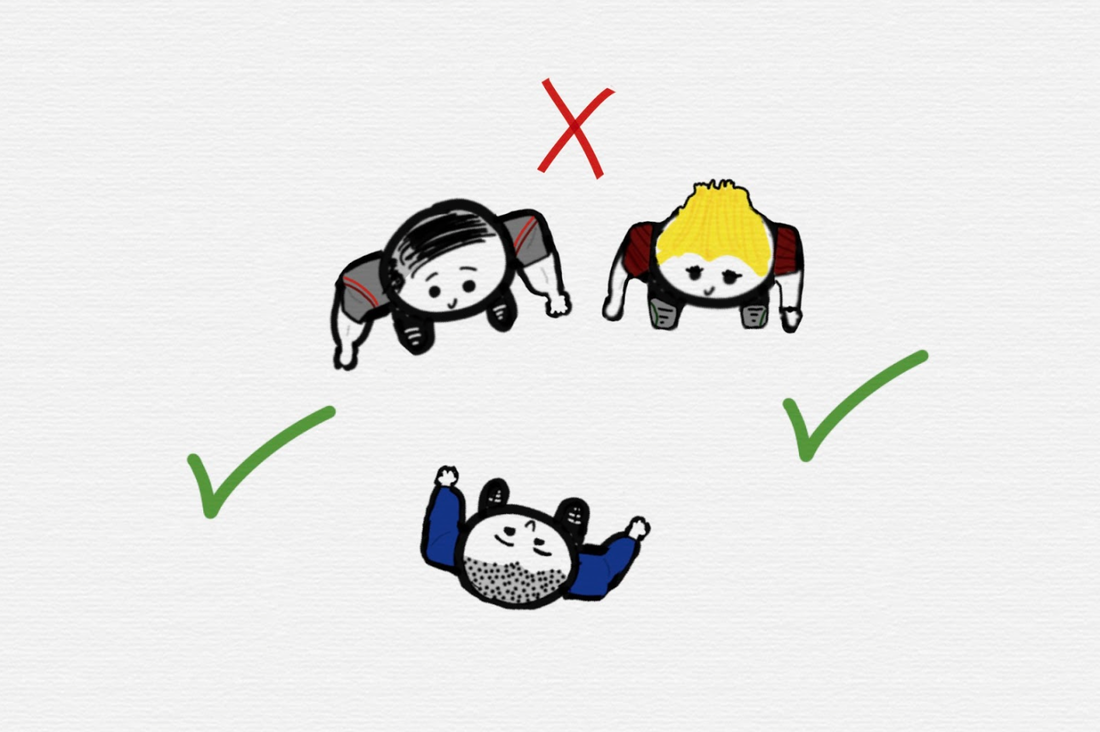
When possible, try to approach from the sides rather than the back...no one enjoys surprises happening behind them.
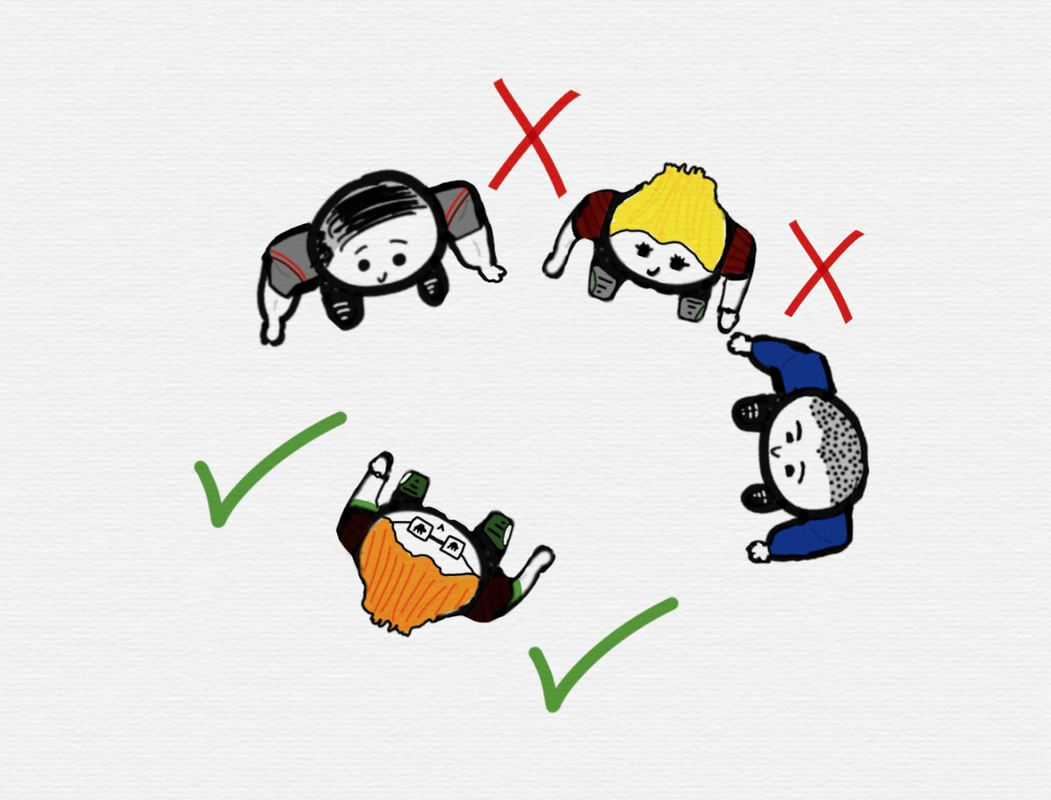
Same rules apply here even though we added a person to the group.
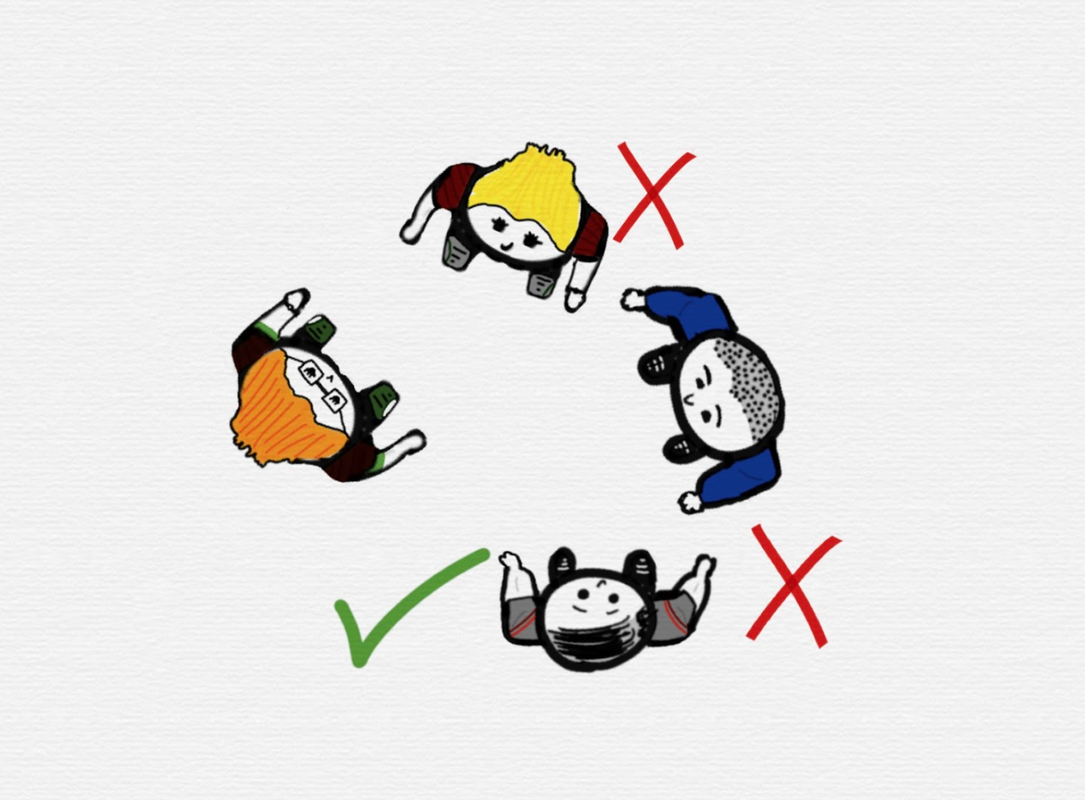
Again, the best approach angle is at the most open part of the group, not from the back.
What should your body language be while approaching a group?
-Smile! This will make you feel great, and other people feel great. It will also let people know you’re probably not a murderer.
-Arms, (and by extension) hands should be relaxed and open. I love fidgeting… but during a conversation, the calmer your body language, the better. If you're wearing shoes, Try rubbing your toes together instead of fidgeting with your hands. Seriously. This works for me.
-Feet should be uncrossed and supportive.
-Avoid collapsed body language, it's fine to take up space.
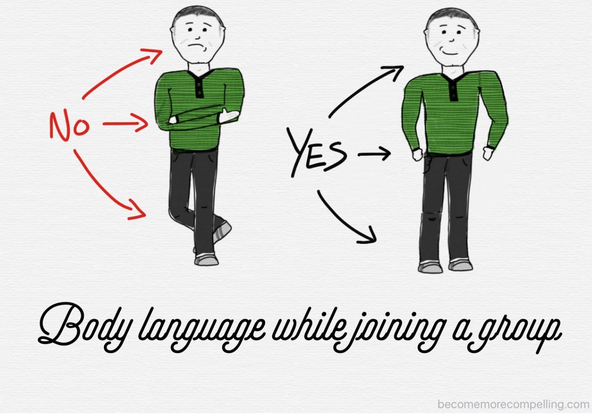
Reading to Doing: Action Steps To Start Using Today
- Ask yourself: what myths about group conversations do you currently believe? Are they helpful? Are they even accurate?
- This week, approach two groups of people. They can be groups at work, at a party, or random strangers. (remember to use time limits, the +10% rule, observe, orient, decide, and act.)
Checklists To Make Sure You're On The Right Track:
[ ] Did you examine your own limiting myths? What did you discover about yourself?
[ ] How can you make yourself comfortable in a group conversation?
[ ] Start small, low-risk conversations throughout your day to inoculate yourself from the fear of approaching new people or groups.
[ ] Use Observe Orient Decide and Act to successfully position yourself while approaching a group.
[ ] Use the +10% rule to always be accepted into a group
[ ] Create 2 basic scripts to use to join a group. Remember that good scripts contain these building blocks: Permission, Time Constraint, and Environment
[ ] Remember to approach groups from the most open point, never from the back.
[ ] Your body language should be open and accessible. Avoid closed-off and collapsed body language.
Part 2: Contributing
BEFORE You Open Your Mouth, Do THIS:
Recently, I visited some friends in Florida, and every morning they would make me an egg burrito.
I loved it. (And I have awesome friends)
So now, every morning I make an egg and spinach burrito.
But before I sit down to enjoy that deliciousness, I do something known in the cooking world as “prep”.
I get my ingredients in order. I place my eggs, spinach, salsa, cheese, and tortillas on the countertop near the burner.I even arrange the cheese and spinach on my tortillas so that all I have to focus on is making eggs.
When the time is right, I can put the ingredients where they need to be. Nobody likes cold eggs in their burrito.
This is important because: Group conversations are challenging enough. Let’s not completely “wing it”--let’s have a plan.Here are the kind of things can you “prep” in advance of group conversation:
-1-3 current things to talk about: Take 3 minutes and scan a few websites before you go out for interesting things to talk about. For a small amount of prep, you can be more interesting than 95% of other people.
Here are some links to get you started:Trending topics on TwitterYahoo Front Page
Facebook trending stories
Save and tag app: Use Pocket for easily tagging stories on the go.
Conversational Sparks. At the end of each topic or blurb, throw out a conversational spark. The purpose of the conversational spark is to...you guessed it, spark a further conversation.
“...what do you guys think? Would you rather A or B?”
“...If you got paid $1,000 would you do XYZ?”
“... I can't believe they did that, what would you guys do in that situation?”
-1-2 stories to tell.
I recently read How To Fall At Almost Everything and Still Win Big by Scott Adams. (The creator of Dilbert)
Adams has a fantastic framework for creating a good story:
- One sentence setup. This prevents you from burdening the story with unnecessary details. Example: “So I got my oil changed yesterday...”
- Establish a pattern. A pattern is useful because once you break it, the story becomes funny. Example: "Every Thursday I get a turkey sandwich from the deli..."
- Finish with a twist. This is when the story becomes funny or interesting. The pattern breaks.
How To Get Out Of Your Head And Stay Present In Group Conversations
A couple of years ago my wife signed up for a local kickball team, and they were having a meet-and-greet at a local dive bar.
We arrive. It's loud.
People are literally throwing (and missing) bottles into a trash can 25 feet away from them. It's some kind of contest. Apparently they do this every Thursday.
There were all these people that seemed to know each other, they were laughing and joking around.
I was sitting there, and my shirt felt uncomfortable. Why did I wear these shoes? I wanted to leave. I felt like an alien, an outsider who had landed at this bar.
I was squarely focused on my internal thoughts and feelings. Which only seemed to make me MORE uncomfortable.
Classic mistake. I had created a vicious cycle. I felt uncomfortable, which made it impossible for me to feel present, which made me uncomfortable.
Rinse and repeat.
Internal to external.
What I should have done: Refocused my energy from myself to connecting with one other person to start, then, I could’ve built on that momentum to have a fun night.
Here are two tools for you to use to stay out of your head and feel present in every group conversation:
Tool #1: Make yourself comfortable / Breathe
Like me in the bar, if you aren’t comfortable...you’re going to have a bad time.n fact...you might even look for any excuse to go home. Not Ideal.
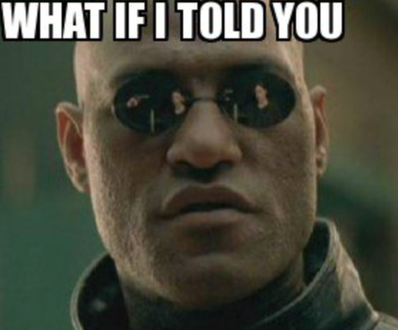
What if I told you that you can manually override your body’s fight-or-flight response?
You can. And there's no bullet dodging involved.
Tool #2: Choose who you want to be, and what you want others to feel.
“The self can presumably be anything you want it to be. It can even be new, but that doesn’t make it insincere or inauthentic.” -Amy Cuddy, Presence
Think about that. You can choose who you want to be in any given situation. And that doesn’t make you inauthentic, in reality, you’re simply adapting to the current situation.
Let’s break this down:
You probably act differently around your friends than you do around your grandmother. Does this mean you’re inauthentic around granny? Not necessarily, you're simply adapting.
But guess what...it’s kinda true. We ALL have different sides of ourselves based on the situation and how we feel that day.
Going into a social situation, you have the option to be however you want to be.
You can be reserved and thoughtful.
You can be outspoken and energetic.
You can be boisterous and goofy.
You're going to adapt, based on the situation.
It's also crucial to consider how you want to make others feel.
This is important, because it shifts the focus from yourself to others. This is a key component of being present.
Do you want other people to feel smart, funny, interesting, or successful?
Ultimately, it's your choice, and you'll change based on the situation.
A dinner party with acquaintances is going to play out differently than watching the Superbowl with three of your closest friends.
Stop treating group conversations like 1:1 conversations
Things can be similar but completely different.
Take basketball and soccer. Both have a ball, goal, and even a net.
But if you look 1% closer, they are vastly different. Basketball is played with hands, soccer is played with feet, the goals are different sizes, the games are even played on different surfaces.
Group conversations and one-on-one conversations might look similar: both involve talkers and listeners, laughter, and hand gestures.
But let’s look closer…
Group conversations are wild and a little unpredictable.(Side note: for more on group vs. one-on-one conversations skip to 15:40)
There will probably be interruptions, people entering and exiting. Groups will typically focus more on entertainment than connection.
I was talking with a client who was treating group conversations like 1:1 conversations. He was trying to go too deep too early. As a general rule, group conversations are going to be a little more surface level.
Remember to focus on these things:
- Keep the conversation light and fun.
- Energy and enthusiasm are your best friends.
- Adapt. Things will change during the conversation, embrace the change.
Topics Are Like Trains, There’s Always Another One Coming
One of my readers was struggling with adapting to sudden changes in conversations.
She felt overly attached to what she wanted to say about a given topic and would by her own admission awkwardly bring up the past topic, shoehorning it into the current topic.
Group conversations are constantly changing. Topics might be abruptly halted in favor of a more interesting topic.
I encouraged her to treat conversational topics like trains. If you miss one, another will show up.
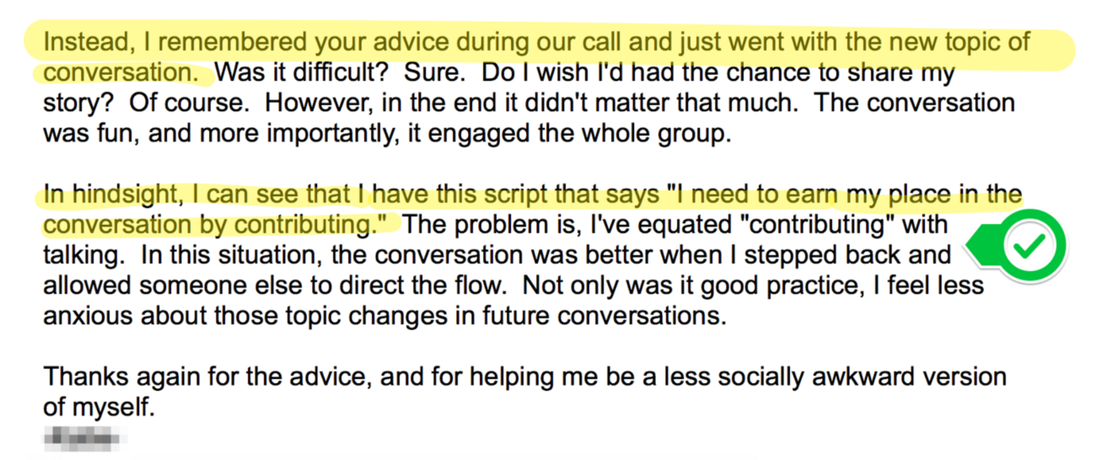
You Don’t Have To CARRY The Conversation (Do This Instead)
Here are two methods that will both help you banish awkward pauses and take away the pressure of carrying the conversation...forever:
The Spokes Method:
Imagine never running out of things to say again.
Sounds great, right?
The spokes method will help you connect with anyone on any topic. Even if you don’t know much about the current topic.
Imagine a bicycle wheel.
In the middle you have a hub, and radiating out from the hub are several spokes.
Now, imagine the hub as the conversational topic. The spokes are different, related topics that can be introduced.
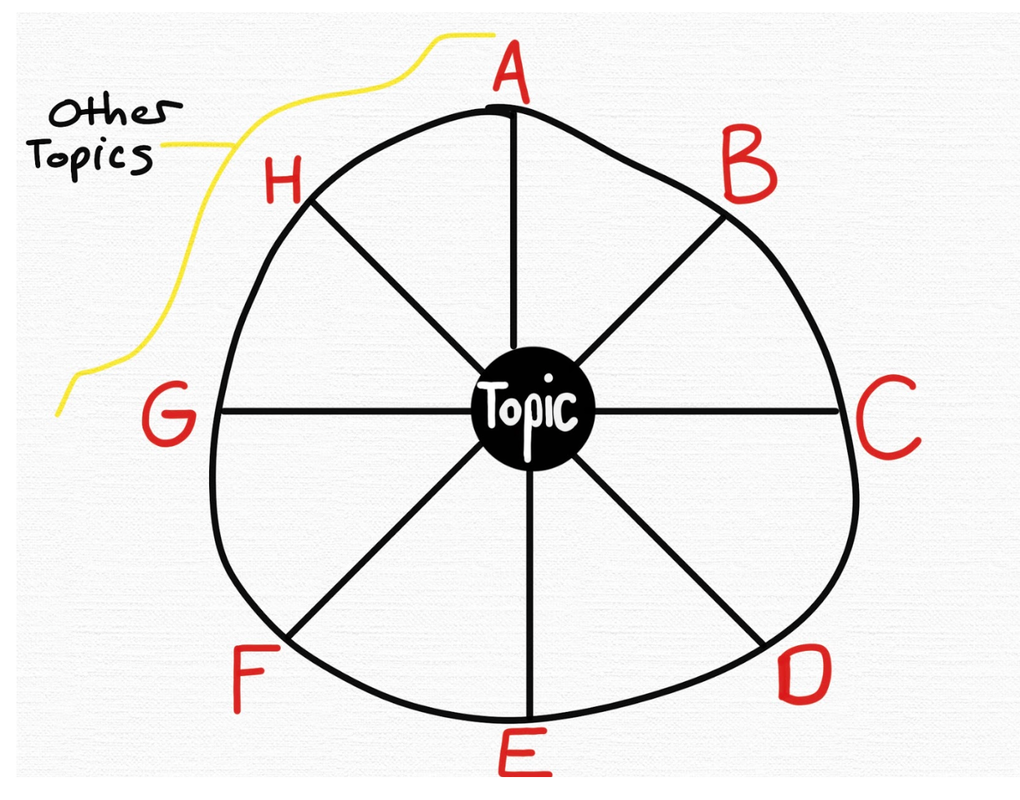
Example: Your friend brings up Star Wars...which you have no interest in, but you want to continue the conversation.
Friend: “Have you seen the new Star Wars movie?”
Star Wars gives me several spokes to play with:
-Movies coming out this year-Space
-What it would be like owning a light-saber in real life
-How Harrison Ford is basically the terminator (Google Harrison Ford Plane Crash)
Friend: “So I've recently gotten into pumpkin carving…”
- “What designs are you thinking about carving?”
- “Do you have any pictures you can show me?”
- “I bet the intricate designs are really difficult”
- “I can't wait for Halloween, one year I went as Marty McFly, but people just thought I was a homeless person”
- “What's your favorite part about carving?”
The key here is knowing that you have options.You can either go broad, or go narrow in your spokes.
Test it out! There's no wrong way to do it.
As you practice, you'll get more calibrated to individual situations.
Spokes is great because it's a win-win…
A win for you because you get to have a great, engaging conversation without awkward silences.
A win for them because (spoiler alert) people love talking about themselves and will leave the conversation thinking that you are awesome.
Here's a video where I explain more about sparks and spokes:
The LOOp Method:
Listen
Observation
Open-ended question
Think of the LOOp method as a way to create a positive feedback loop during conversations.
It also helps you remain present because this method forces you to remain an active participant in conversations.
Let's break down the different components of the LOOp method:
Listen. Think about the last time you felt listened to.
Now think about the last time you were talking to someone who seemed “spring-loaded” with something to say as soon as you were done speaking.
Which person should you rather have a conversation with?
The best conversationalists know that listening is the number one skill you can cultivate.
Why?
Listening is a powerful way to foster a connection between two people.
And listening goes beyond the standard “active listing” stuff that largely doesn’t matter (if you’re actually listening, you’ll nod and say things like “I see…” automatically)
Award winning journalist Celeste Headlee's TED Talk on 10 Ways To Have A Better Conversation. (#9 is listening)

-Observations. An added component to listening is the observation. Observations do two things at once:
- Show the other person that you listened.
- Forces you to stay present in the conversation because you’re literally commenting on something the other person said.
Example: “Wow, I bet moving across the country was exciting!
-Open questions. This is some ninja-level stuff right here. Asking open-ended questions is an insanely useful, yet easy to learn skill that will put you in the top 5% of conversationalists instantly.Open questions can’t be answered with a yes or no. They require a more in depth answer.
Here’s what that might look like tied on the end of the earlier observation: “Wow, I bet moving across the country was exciting...why San Francisco?”
This begs for a longer discussion, and in a group setting you’re actually giving people a platform to tell the group more about themselves.
It’s like you’re a late night talk show host and you’ve got multiple guests on your show.
Other examples of open questions:
“Why xyz?”
“What was that moment like for you?”
“How did you get into xyz?”
“How did you meet xyz?”
“How do you go about doing xyz?”
“Why did you want to do xyz?
The LOOp method and the Spokes method are powerful ways to keep the conversation going so that you create a deeper connection with the people in your group.
Small Talk Spotlight: Dan Chang

Dan Chang is a former self-described shy guy. Nine years ago Dan decided to start learning about social skills so that he could perform at a high level in his career.
He's gone from someone who was too shy to speak up in meetings, to giving presentations to executives.
I invited Dan on my podcast, and he outlined his three step framework to master small talk.
The overall goal of Dan’s framework is to highlight similarity.
- Move from what to why. In every conversation, you’re going to go from cliches (e.g. “Nice weather today.”) to facts (“What did you do this weekend?”) to opinions (“I love that movie!”) to feelings (“I’m excited about…”) You want to move along that progression from cliches > facts > opinions > feelings.
- Affirm what they say. Reward them for sharing. Use both verbal and nonverbal signals. Nodding and saying “Yeah, I totally get that.” will make the other person feel great for sharing and set the stage for a deeper conversation.
- Relate with your own opinions and feelings. If you have an opinion or feeling about what the other person said, voice it! People love finding out that they have common interests. This will foster a deeper shared connection between you.
I’d recommend listening to our entire conversation because we cover:
13:55 How to make yourself comfortable before you even open your mouth.
15:50 A simple tip that Dan's boss gave him: You don't have to have a great idea to say something.
18:45 Dan talks about the dangers of too much prep before conversations.
24:20 Why you should avoid too much self focus during conversations.
How to Jump Into a Conversation That Has No Opening
A couple of years ago, my wife was at a literary festival, and she struck up a conversation with an author, then another author joined, and authors 1 and 2 started talking and my wife wanted to contribute, but their were no openings for her to jump in.
From what we've covered so far, you now know how to contribute in a conversation. But how the hell do you jump into a conversation that seems to have no gaps, no pauses, no opening to start talking?
And how do you jump in without cutting anyone off or making them feel interrupted?
It might seem like breaking into Fort Knox, but as you'll see, it's part mindset, part technique.
It's okay to jump in during a group conversation.
But I'm also going to add a caveat: It's okay to jump in as long as the other person feels validated.
What does this mean?
Simply put, make them feel good about what they just said.
Phrases like:
“That's a really good point, because [SPECIFIC REASON]”
“I like what you just said, because [SPECIFIC REASON]”
“That reminds me of XYZ because…[SPECIFIC REASON]”
Notice the use of validating the other person by giving a specific reason based on something they said. This does two things:
- Shows them you were listening (notice listening as a recurring theme?)
- Makes them feel good about what they said.
Rewire Your Thoughts by Celebrating Small Wins
As you improve your group conversation skills, you’ll have great interactions, and lukewarm interactions. Remember to celebrate the small wins as you improve.
Whenever we learn a new skill, we tend to have massive improvement early, plateau, then incremental improvement as we become better. (If you start running, dropping your mile time from 10 minutes to 7 minutes might take only a few months, but dropping from 7 minutes to 6 minutes might take a year.
So how do we celebrate our wins as we improve?
Expert Spotlight: Tim Ferriss
Three time New York Times best selling author Tim Ferriss has an interesting habit that he uses to celebrate his wins:

Fast forward to 14:14
It’s important to focus on the things you’re doing well, so that you can both appreciate your improvement, as well as increase the perception that you’re the kind of person who can (and does) perform well in group settings.
Whether it’s a mason jar full of scraps of paper, or a notes file on your phone, cultivating awareness of where you are as you improve your skills will help you appreciate your journey.
Here’s the app I use: The 5 Minute Journal.
Reading To Doing: Action Steps To Using Today
This week as you find yourself in those conversations, focus on using the LOOps and Spokes method to enhance the conversation. Also, if you think of something REALLY great to say, but the moment has passed. Let it go.
Remember: Topics are like trains, there's always another one coming. (This will help you stay present in the conversation)
Checklist To Make Sure You're On The Right Track:
[ ] Did you prepare 1-3 interesting stories and conversational sparks?
[ ] What steps could you take to feel comfortable in a group? (Remember to breathe, and remember that you can choose who you want to be without being inauthentic.
[ ] Group Conversations have a different vibe than 1:1 conversations.
[ ] Being adaptable is a skill, when you have the perfect thing to say, but the moment has passed, that's okay. Topics are like trains, there's always another one coming.
[ ] Use the Spokes method to uncover related topics that you can talk about.
[ ] Use the LOOp method to remain engaged and present in the conversation.
[ ] If there are no gaps in the conversation, jump in without being rude or cutting people off.
[ ] Celebrate small wins by writing them down.
3 ways I can help you level up your communication skills:
1. Private Coaching: I’m the secret weapon top Performers at Google, Netflix, and the US Army trust for people skills coaching. Imagine what I can do for you.
2. Social Accelerator: Social Accelerator is my proven self-paced + group coaching system for turning social awkwardness into confidence, overthinking into action, and hesitation into meaningful connections.
3. My group convos audio guide. Join over 5,000 overthinkers who have supercharged their group conversation skills using tested strategies in my 56-minute audio training.

I'm Jeff Callahan
I make it nearly impossible for overthinkers to fail at improving their people skills. (I've helped hundreds of people over the last 10 years)
Want to never run out of things to say in conversation again so you connect with more people and make new friends?
Want to speak up more in important meetings at work so you get promoted faster and have an awesome career?
Want to develop unshakeable social confidence and competence so you can walk into any room and feel like you belong there?
As your coach, I'll help you move forward faster.



















